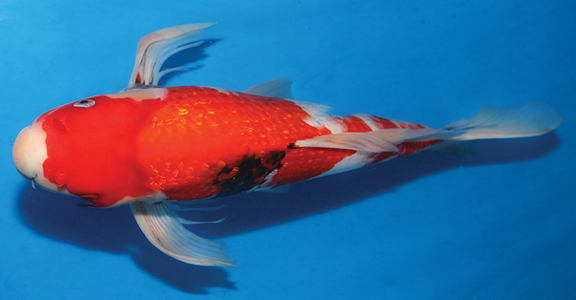
There are so many names for this variety — hirenaga (“long fin”), onaga (“long tail”), tenaga (“long arm”) and hagoromo (“celestial robe of an angel”) are just a few. I like to use Hirenaga, because it is the most commonly used.
Hirenaga’s History
Few people know that Hirenaga breeding traces back to Japan’s emperor. When the emperor of Japan, Akihito, was the prince in 1962, he visited Indonesia and saw longfin carp. He thought it would be interesting to cross the Indonesian longfin carp with Japanese koi. He suggested this idea to Saitama Prefecture’s Inland Water Fisheries Experiment Station. The station succeeded to develop five Hirenaga varieties. In 1991, 22 Hirenaga koi were released to a pond at the palace. It is no exaggeration that Hirenaga koi would not have existed for our enjoyment without Emperor Akihito.
Unfortunately, Hirenaga did not gain much popularity in Japan. Instead, it became very popular overseas. In the United States, for example, there are Hirenaga divisions at koi shows, while there are none in Japan. I believe this stems from the different aesthetic senses of each culture. Because their fins are long, they are easy to split or tear. Personally, I think this imperfection might have bothered the Japanese eye.
However, I must admit that Hirenaga have made a very big contribution to the koi world. Because Hirenaga blood can be introduced to any variety, it literally doubles the varieties of Japanese koi.
Identification
Appreciation of Hirenaga is very simple. Though the long fin is its main characteristic, the shape and beauty of the fin is the most important part. After this has been identified, we can check the koi according to the standards of each variety.
When you look at the fins, ideally they should be long and symmetrical with no tears. Take a look at the examples in the pictures. The pictures of koi D(image) and E (image) show some fin faults — they are uneven and curled. Due to the high difficulty of breeding ideal, long fins, it should not be criticized too much. But I believe these examples should give you an idea of what to look for.
After checking the shape of fins, the standards of each variety need to be checked. For example, koi A is a Tancho Sanke (click here to view). So, we need to examine the shape of the circle on its head. The quality and location of the sumi are important in the Sanke variety.
Koi C is beautiful (click here to view), otherwise perfect Shusui variety, but it is unfortunate that the pectoral fins are a bit torn. In Shusui, because it is a Doitsu (scaleless) variety, the scales on its back are the most important. You can see that the consistent indigo-colored zipper line goes perfectly from its shoulder to its tail. Then, we look at the clean head and body and hi markings. I must say, this koi has excellent features in this regard. If you come across this kind of Hirenaga Shusui, grab it right away before somebody else takes it!

Koi E is also Taisho Sanke (click here to view). It has such a nice four-step Kohaku pattern. Sumi, which are emerging, are excellent in quality and location. Although it has some weaknesses on its fin, the standard of this Taisho Sanke is very high.
Where to Find Them
Although Hirenaga are not popular in Japan, there are two excellent breeders in Niigata. If you consider the fact that more than 80 percent of Japanese Koi are exported, it seems natural that some breeders want to breed quality Hirenaga.
I recommend two breeders: the Yamasan Koi Farm, which breeds many metallic Hirenaga, and the Suda Koi Farm, which breeds many Hirenaga with Gosanke, Kohaku, Sanke and Showa. Please always make sure to check the koi breeder when you are going to buy or sell.



Very nice variety. But I think high fins still are not included in koi show competition.